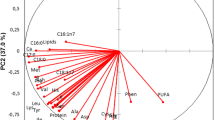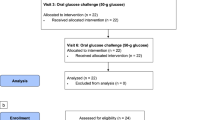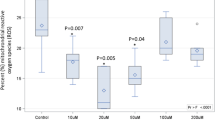Abstract
Our results indicate that there is an increase in total antioxidant capacity (TAC) and (–)epicatechin content of plasma in people who have consumed dark chocolate, and that these effects are reduced by the presence of milk1. Halliwell and Schroeter et al. raise issues that are central to the debate over the fate and potential protective effects of dietary antioxidants.
Similar content being viewed by others
Serafini et al. reply
Schroeter et al. suggest that a matrix effect in our study may have delayed the absorption of antioxidants when chocolate was consumed with milk, and that this went unnoticed because our experiments were terminated after 4 h. However, this is unlikely for several reasons. All of the participants in our trials fasted overnight for 12 h and, after supplementation with chocolate/milk, no other product was consumed for the duration of the experiment. Individuals who ate dark chocolate showed a significant increase in plasma TAC after 1 h and in plasma (–)epicatechin for 4 h after ingestion (as measured by the area under the curve in Fig. 1a of ref. 1). In a pilot study, we also monitored plasma TAC for 6 h (results not shown) and found no increase following the consumption of either milk chocolate or dark chocolate with milk.
The study described by Schroeter et al. differs in key respects from ours. The authors used a chocolate beverage, rather than solid chocolate. The amount of milk consumed with the beverage is not stated but, on the basis of the lipid content (3% as opposed to 30%), it is substantially less than in our study, which could explain why they did not observe an inhibition of plasma TAC by milk. Another factor could be that Schroeter et al. measured plasma TAC by using the TRAP-luminol assay, which is unlike the FRAP assay that we used in that it measures radical-scavenging activity rather than reducing power, and as such determines a different feature of TAC2.
We were careful to distinguish between TAC and (–)epicatechin absorption because the aim of our investigation was to evaluate the effect of food associations on plasma TAC, and not to identify the compounds responsible for the effect. We agree that the increase in plasma TAC cannot be explained solely on the basis of increased (–)epicatechin levels. Other chocolate polyphenols, such as procyanidins or their in vivo metabolites, could also be involved in increasing FRAP values. However, whatever the components responsible, they too are likely to be affected by milk, causing a reduction in vivo in the antioxidant properties of dark chocolate.
We measured urate concentrations in plasma under similar conditions (results not shown) and the results are commensurate with an involvement of urate in the redox network. However, as noted by Halliwell, the situation is not straightforward and we did not therefore speculate on the contribution of urate in this context.
TAC measurement is increasingly being used to monitor redox status in vivo as well as for epidemiological purposes3. Understanding the factors that regulate plasma TAC will help to clarify the interplay between plant-derived foods, plasma redox status and oxidative disease; the effect of food associations on TAC in vivo is just one, albeit complicated, variable.
References
Serafini, M. et al. Nature 424, 1013 (2003).
Del Rio, D., Serafini, M. & Pellegrini, N. Nutr. Met. Card. Dis. 12, 343–351 (2002).
Serafini, M., Bellocco, R., Wolk, A. & Ekström, A. M. Gastroenterology 123, 985–991 (2002).
Author information
Authors and Affiliations
Corresponding author
Rights and permissions
About this article
Cite this article
Serafini, M., Crozier, A. Milk and absorption of dietary flavanols. Nature 426, 788 (2003). https://doi.org/10.1038/426788a
Issue Date:
DOI: https://doi.org/10.1038/426788a
Comments
By submitting a comment you agree to abide by our Terms and Community Guidelines. If you find something abusive or that does not comply with our terms or guidelines please flag it as inappropriate.



